Planning for Aged Protection from Heat Stroke: Digital Tech
VerifiedAdded on 2023/03/21
|22
|5456
|28
Report
AI Summary
This report focuses on protecting the aged population from the health risks of climate change, particularly heat stroke, using digital technology. It highlights the increasing global temperatures, especially in Australia, and the vulnerability of the elderly to heat-related illnesses. The report emphasizes the need for early warning systems, preventive measures, and government policies to mitigate these risks. It explores the implementation of heat health warning systems, the use of digital technologies like smart watches, and the importance of local government involvement. The rationale behind the study is the growing elderly population and the increasing frequency and intensity of heat waves. The report aims to provide strategies and solutions to minimize the effects of climatic changes on the aged population through digital technology. It includes an introduction, rationale, aim, methods, and implementation sections, as well as a discussion and conclusion. The report stresses the need for further research on the effectiveness of interventions and the importance of collaboration among various health and social care organizations.
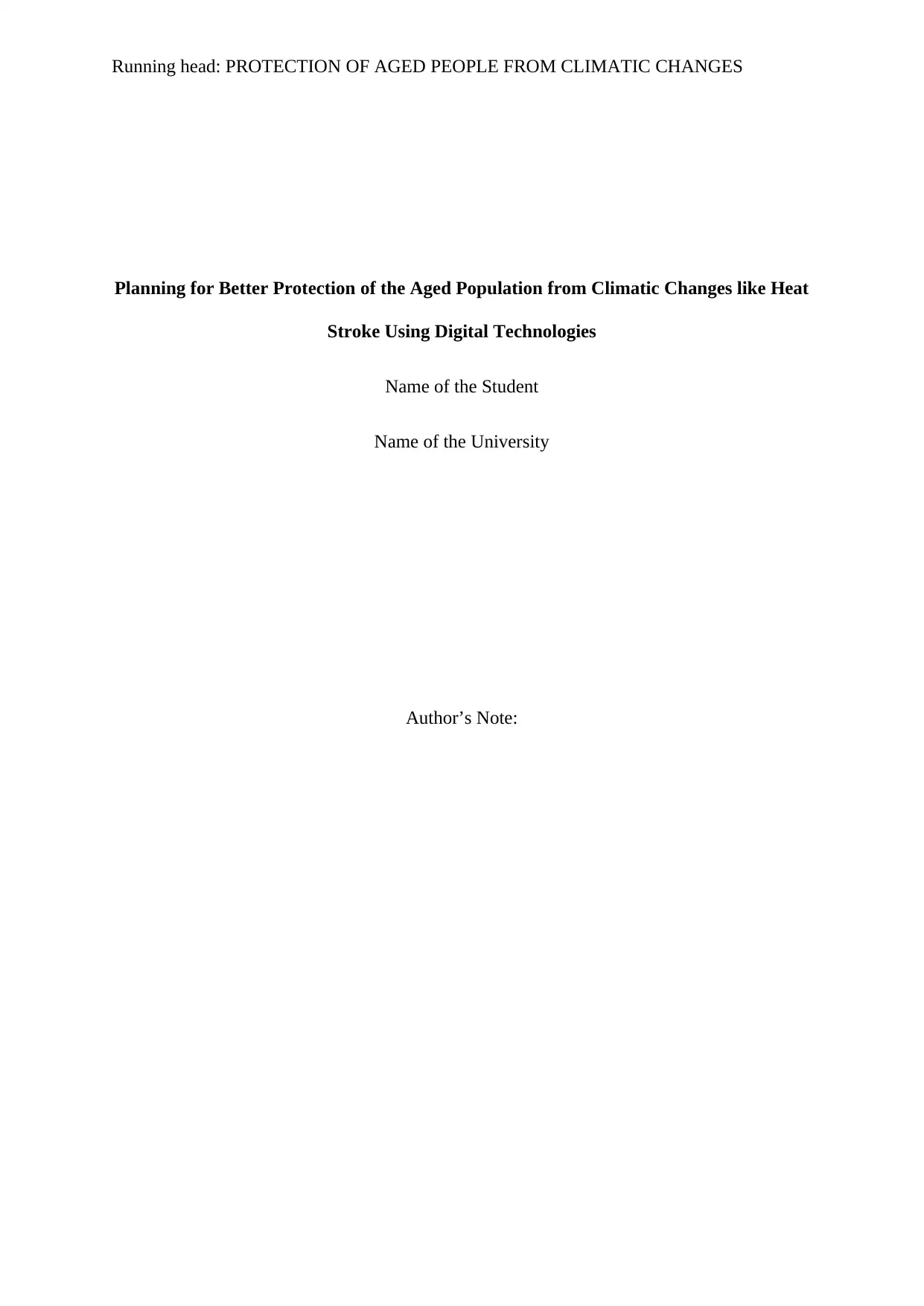
Running head: PROTECTION OF AGED PEOPLE FROM CLIMATIC CHANGES
Planning for Better Protection of the Aged Population from Climatic Changes like Heat
Stroke Using Digital Technologies
Name of the Student
Name of the University
Author’s Note:
Planning for Better Protection of the Aged Population from Climatic Changes like Heat
Stroke Using Digital Technologies
Name of the Student
Name of the University
Author’s Note:
Paraphrase This Document
Need a fresh take? Get an instant paraphrase of this document with our AI Paraphraser
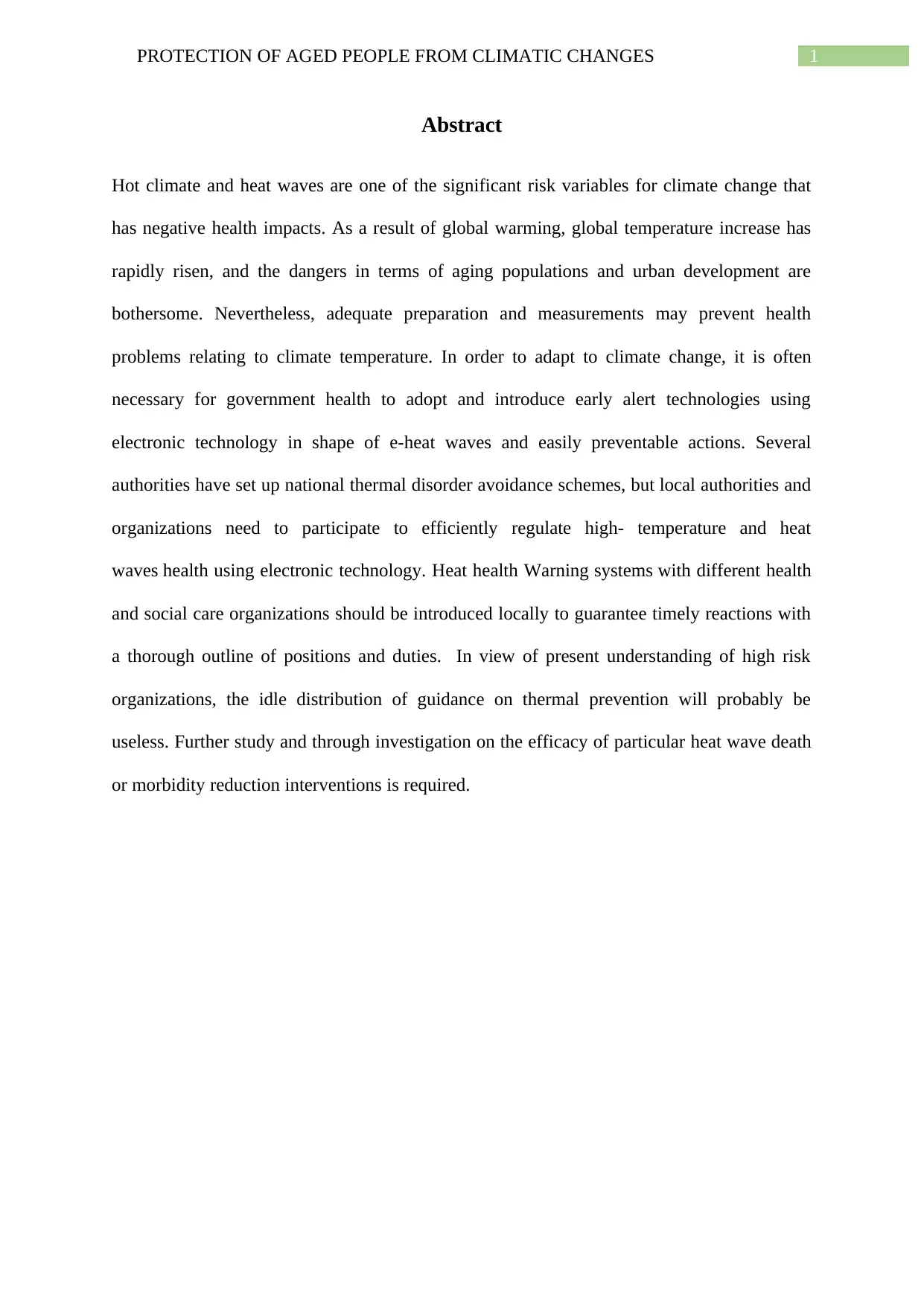
1PROTECTION OF AGED PEOPLE FROM CLIMATIC CHANGES
Abstract
Hot climate and heat waves are one of the significant risk variables for climate change that
has negative health impacts. As a result of global warming, global temperature increase has
rapidly risen, and the dangers in terms of aging populations and urban development are
bothersome. Nevertheless, adequate preparation and measurements may prevent health
problems relating to climate temperature. In order to adapt to climate change, it is often
necessary for government health to adopt and introduce early alert technologies using
electronic technology in shape of e-heat waves and easily preventable actions. Several
authorities have set up national thermal disorder avoidance schemes, but local authorities and
organizations need to participate to efficiently regulate high- temperature and heat
waves health using electronic technology. Heat health Warning systems with different health
and social care organizations should be introduced locally to guarantee timely reactions with
a thorough outline of positions and duties. In view of present understanding of high risk
organizations, the idle distribution of guidance on thermal prevention will probably be
useless. Further study and through investigation on the efficacy of particular heat wave death
or morbidity reduction interventions is required.
Abstract
Hot climate and heat waves are one of the significant risk variables for climate change that
has negative health impacts. As a result of global warming, global temperature increase has
rapidly risen, and the dangers in terms of aging populations and urban development are
bothersome. Nevertheless, adequate preparation and measurements may prevent health
problems relating to climate temperature. In order to adapt to climate change, it is often
necessary for government health to adopt and introduce early alert technologies using
electronic technology in shape of e-heat waves and easily preventable actions. Several
authorities have set up national thermal disorder avoidance schemes, but local authorities and
organizations need to participate to efficiently regulate high- temperature and heat
waves health using electronic technology. Heat health Warning systems with different health
and social care organizations should be introduced locally to guarantee timely reactions with
a thorough outline of positions and duties. In view of present understanding of high risk
organizations, the idle distribution of guidance on thermal prevention will probably be
useless. Further study and through investigation on the efficacy of particular heat wave death
or morbidity reduction interventions is required.
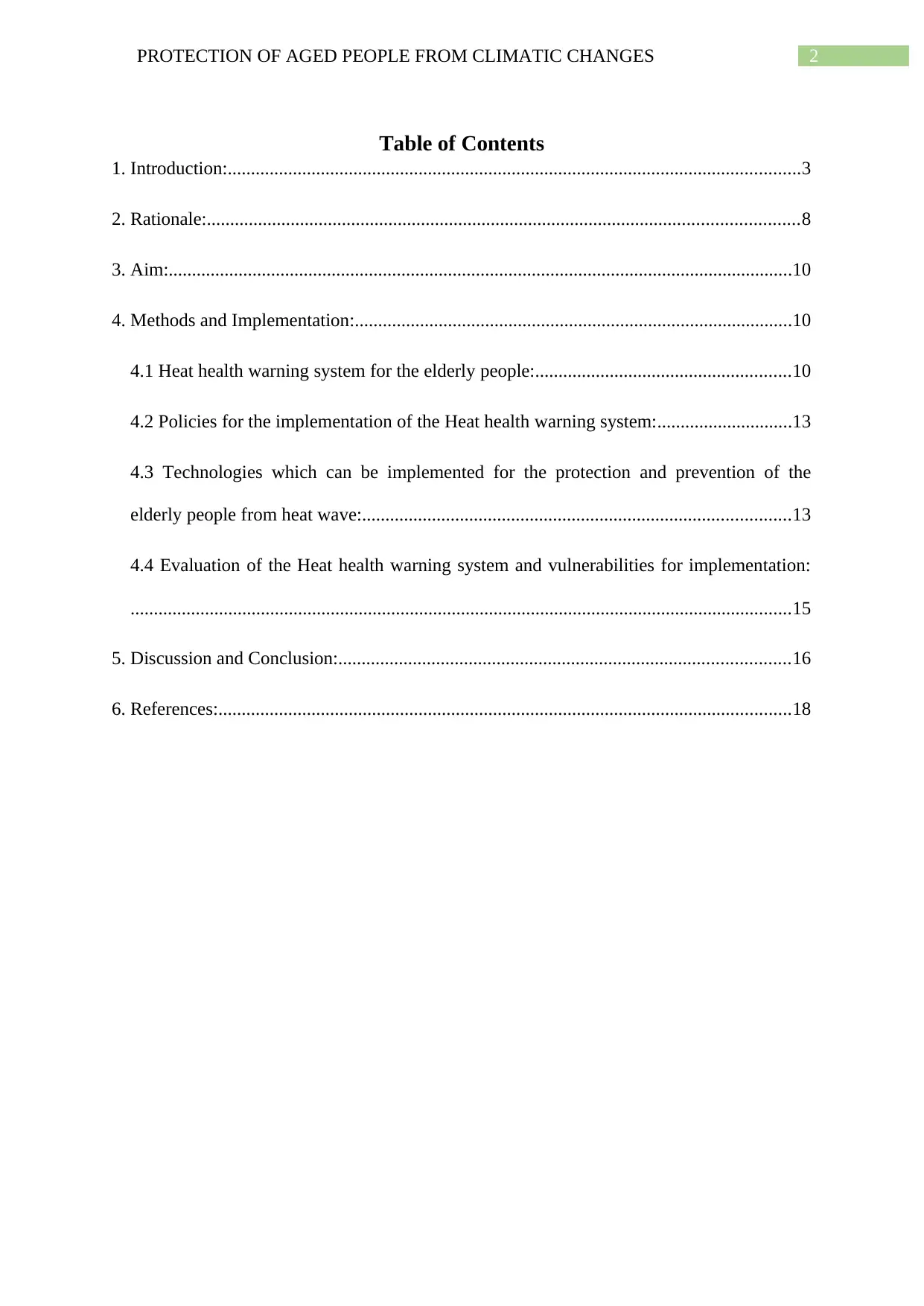
2PROTECTION OF AGED PEOPLE FROM CLIMATIC CHANGES
Table of Contents
1. Introduction:...........................................................................................................................3
2. Rationale:...............................................................................................................................8
3. Aim:......................................................................................................................................10
4. Methods and Implementation:..............................................................................................10
4.1 Heat health warning system for the elderly people:.......................................................10
4.2 Policies for the implementation of the Heat health warning system:.............................13
4.3 Technologies which can be implemented for the protection and prevention of the
elderly people from heat wave:............................................................................................13
4.4 Evaluation of the Heat health warning system and vulnerabilities for implementation:
..............................................................................................................................................15
5. Discussion and Conclusion:.................................................................................................16
6. References:...........................................................................................................................18
Table of Contents
1. Introduction:...........................................................................................................................3
2. Rationale:...............................................................................................................................8
3. Aim:......................................................................................................................................10
4. Methods and Implementation:..............................................................................................10
4.1 Heat health warning system for the elderly people:.......................................................10
4.2 Policies for the implementation of the Heat health warning system:.............................13
4.3 Technologies which can be implemented for the protection and prevention of the
elderly people from heat wave:............................................................................................13
4.4 Evaluation of the Heat health warning system and vulnerabilities for implementation:
..............................................................................................................................................15
5. Discussion and Conclusion:.................................................................................................16
6. References:...........................................................................................................................18
⊘ This is a preview!⊘
Do you want full access?
Subscribe today to unlock all pages.

Trusted by 1+ million students worldwide
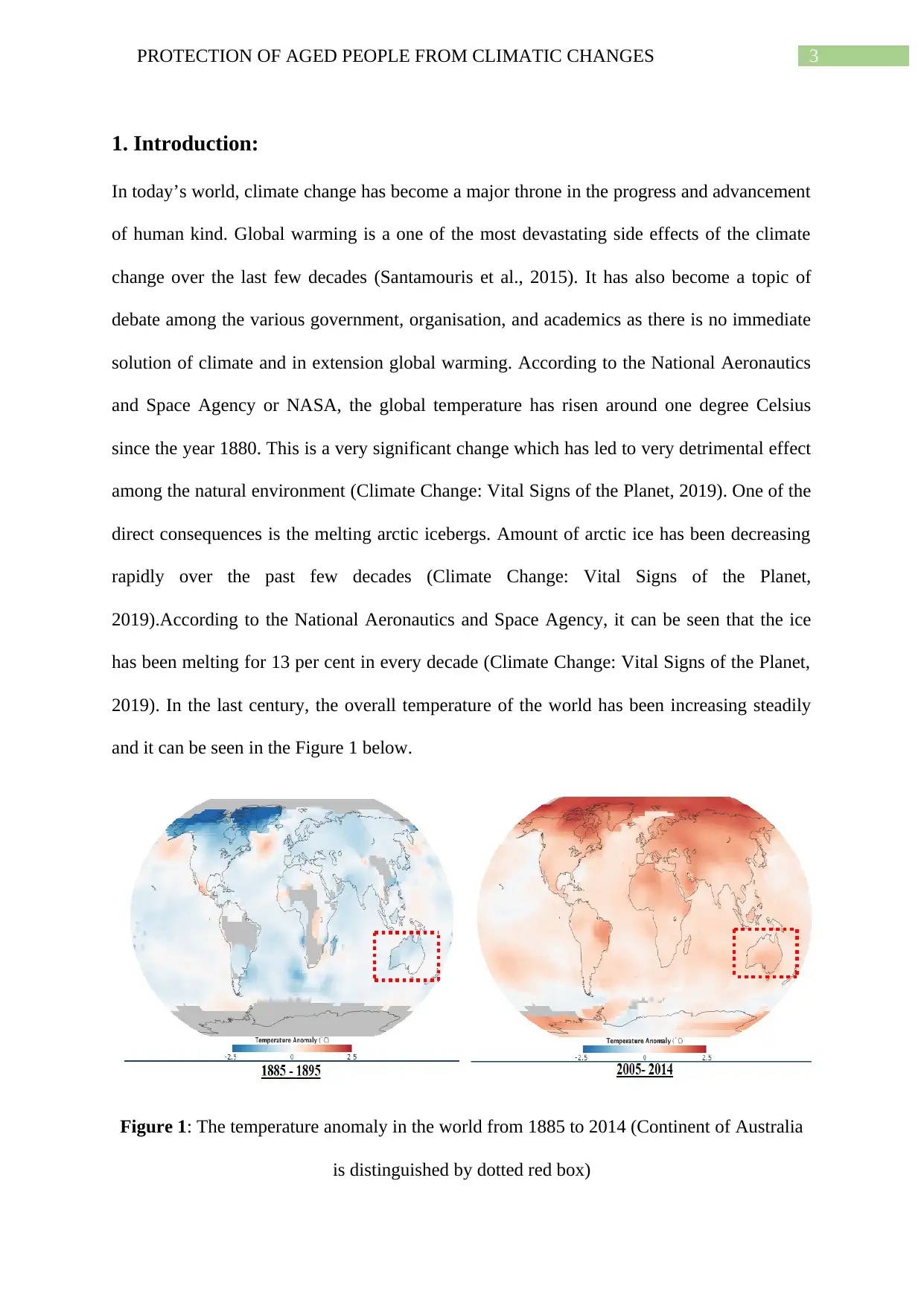
3PROTECTION OF AGED PEOPLE FROM CLIMATIC CHANGES
1. Introduction:
In today’s world, climate change has become a major throne in the progress and advancement
of human kind. Global warming is a one of the most devastating side effects of the climate
change over the last few decades (Santamouris et al., 2015). It has also become a topic of
debate among the various government, organisation, and academics as there is no immediate
solution of climate and in extension global warming. According to the National Aeronautics
and Space Agency or NASA, the global temperature has risen around one degree Celsius
since the year 1880. This is a very significant change which has led to very detrimental effect
among the natural environment (Climate Change: Vital Signs of the Planet, 2019). One of the
direct consequences is the melting arctic icebergs. Amount of arctic ice has been decreasing
rapidly over the past few decades (Climate Change: Vital Signs of the Planet,
2019).According to the National Aeronautics and Space Agency, it can be seen that the ice
has been melting for 13 per cent in every decade (Climate Change: Vital Signs of the Planet,
2019). In the last century, the overall temperature of the world has been increasing steadily
and it can be seen in the Figure 1 below.
Figure 1: The temperature anomaly in the world from 1885 to 2014 (Continent of Australia
is distinguished by dotted red box)
1. Introduction:
In today’s world, climate change has become a major throne in the progress and advancement
of human kind. Global warming is a one of the most devastating side effects of the climate
change over the last few decades (Santamouris et al., 2015). It has also become a topic of
debate among the various government, organisation, and academics as there is no immediate
solution of climate and in extension global warming. According to the National Aeronautics
and Space Agency or NASA, the global temperature has risen around one degree Celsius
since the year 1880. This is a very significant change which has led to very detrimental effect
among the natural environment (Climate Change: Vital Signs of the Planet, 2019). One of the
direct consequences is the melting arctic icebergs. Amount of arctic ice has been decreasing
rapidly over the past few decades (Climate Change: Vital Signs of the Planet,
2019).According to the National Aeronautics and Space Agency, it can be seen that the ice
has been melting for 13 per cent in every decade (Climate Change: Vital Signs of the Planet,
2019). In the last century, the overall temperature of the world has been increasing steadily
and it can be seen in the Figure 1 below.
Figure 1: The temperature anomaly in the world from 1885 to 2014 (Continent of Australia
is distinguished by dotted red box)
Paraphrase This Document
Need a fresh take? Get an instant paraphrase of this document with our AI Paraphraser
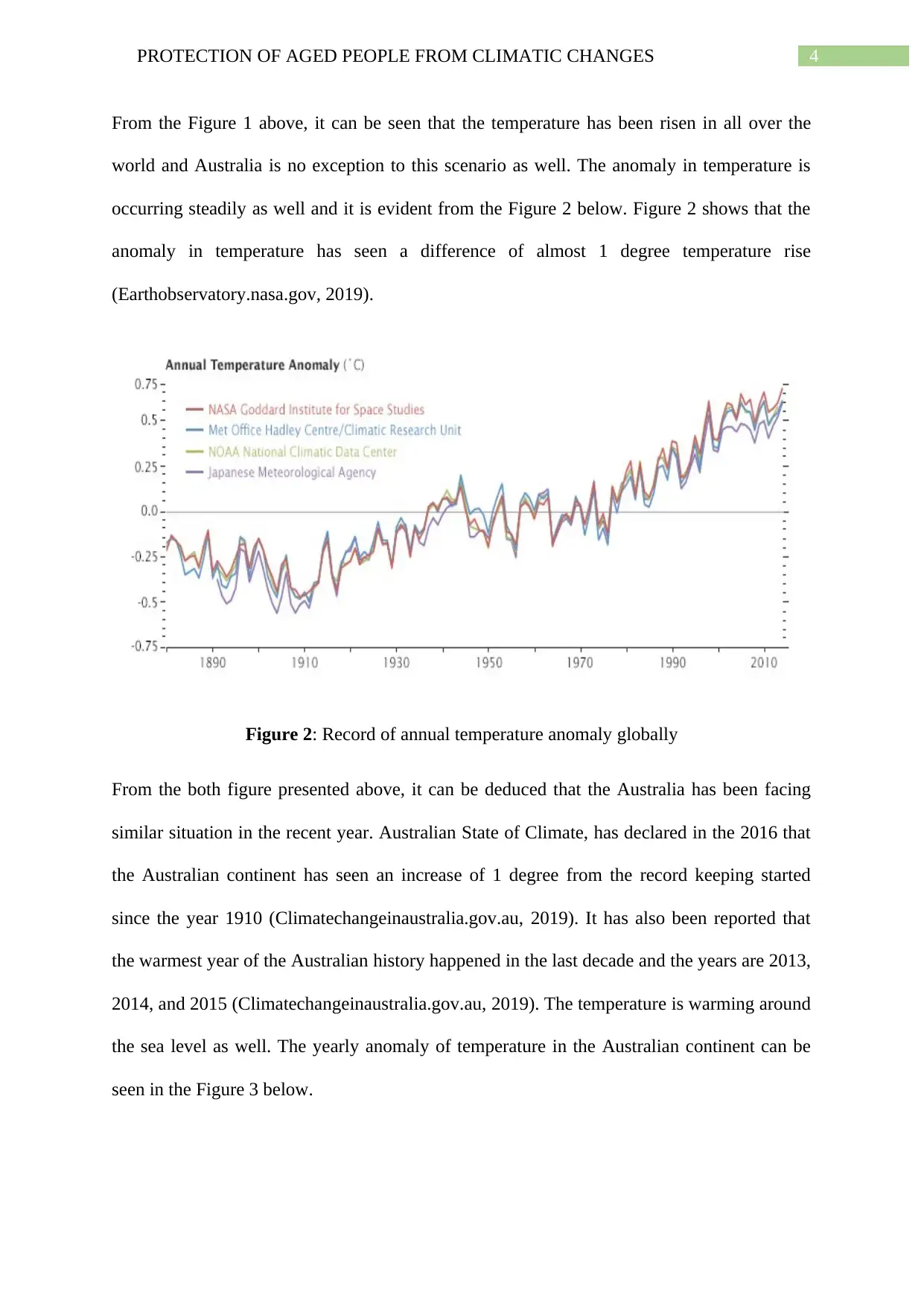
4PROTECTION OF AGED PEOPLE FROM CLIMATIC CHANGES
From the Figure 1 above, it can be seen that the temperature has been risen in all over the
world and Australia is no exception to this scenario as well. The anomaly in temperature is
occurring steadily as well and it is evident from the Figure 2 below. Figure 2 shows that the
anomaly in temperature has seen a difference of almost 1 degree temperature rise
(Earthobservatory.nasa.gov, 2019).
Figure 2: Record of annual temperature anomaly globally
From the both figure presented above, it can be deduced that the Australia has been facing
similar situation in the recent year. Australian State of Climate, has declared in the 2016 that
the Australian continent has seen an increase of 1 degree from the record keeping started
since the year 1910 (Climatechangeinaustralia.gov.au, 2019). It has also been reported that
the warmest year of the Australian history happened in the last decade and the years are 2013,
2014, and 2015 (Climatechangeinaustralia.gov.au, 2019). The temperature is warming around
the sea level as well. The yearly anomaly of temperature in the Australian continent can be
seen in the Figure 3 below.
From the Figure 1 above, it can be seen that the temperature has been risen in all over the
world and Australia is no exception to this scenario as well. The anomaly in temperature is
occurring steadily as well and it is evident from the Figure 2 below. Figure 2 shows that the
anomaly in temperature has seen a difference of almost 1 degree temperature rise
(Earthobservatory.nasa.gov, 2019).
Figure 2: Record of annual temperature anomaly globally
From the both figure presented above, it can be deduced that the Australia has been facing
similar situation in the recent year. Australian State of Climate, has declared in the 2016 that
the Australian continent has seen an increase of 1 degree from the record keeping started
since the year 1910 (Climatechangeinaustralia.gov.au, 2019). It has also been reported that
the warmest year of the Australian history happened in the last decade and the years are 2013,
2014, and 2015 (Climatechangeinaustralia.gov.au, 2019). The temperature is warming around
the sea level as well. The yearly anomaly of temperature in the Australian continent can be
seen in the Figure 3 below.
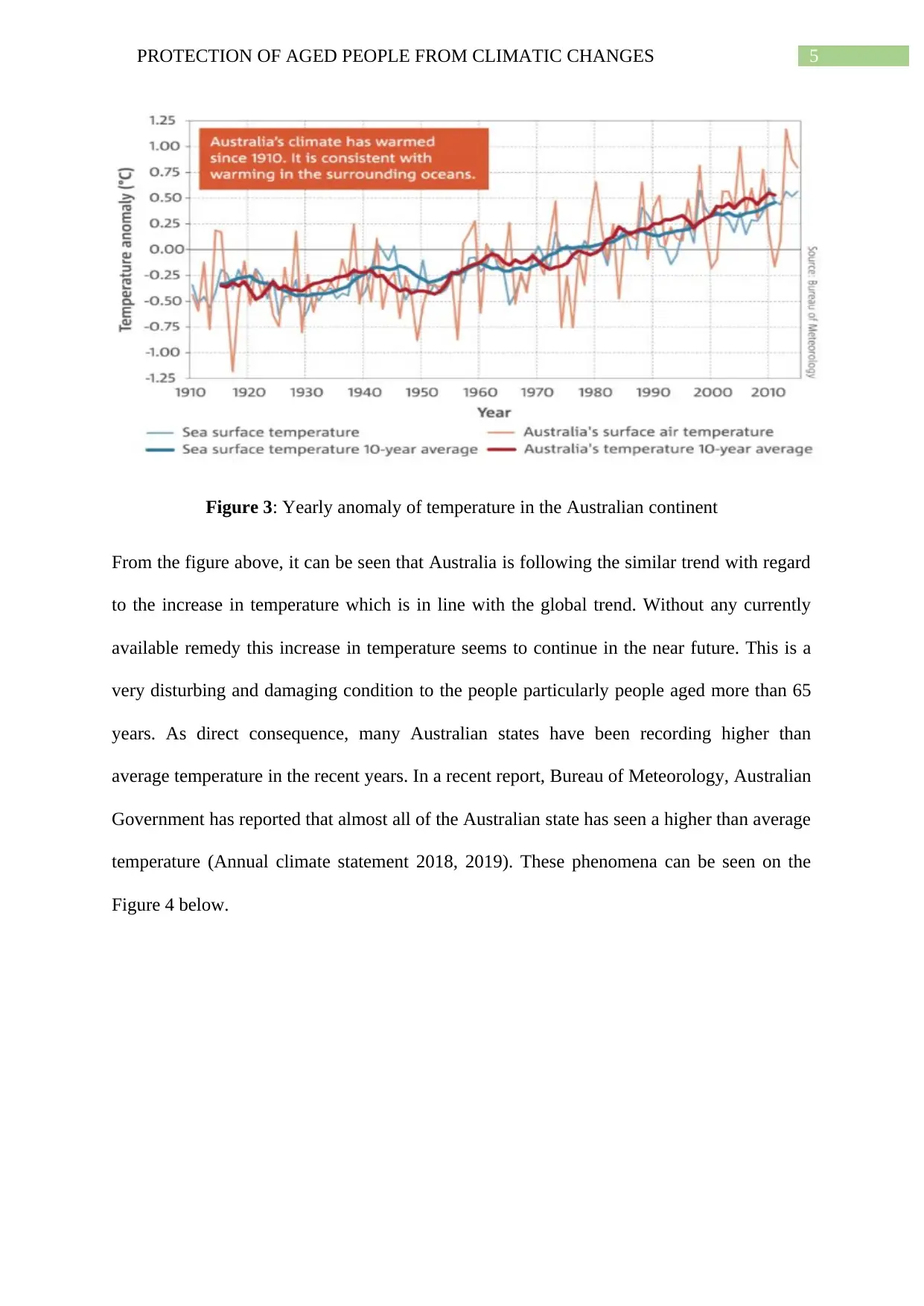
5PROTECTION OF AGED PEOPLE FROM CLIMATIC CHANGES
Figure 3: Yearly anomaly of temperature in the Australian continent
From the figure above, it can be seen that Australia is following the similar trend with regard
to the increase in temperature which is in line with the global trend. Without any currently
available remedy this increase in temperature seems to continue in the near future. This is a
very disturbing and damaging condition to the people particularly people aged more than 65
years. As direct consequence, many Australian states have been recording higher than
average temperature in the recent years. In a recent report, Bureau of Meteorology, Australian
Government has reported that almost all of the Australian state has seen a higher than average
temperature (Annual climate statement 2018, 2019). These phenomena can be seen on the
Figure 4 below.
Figure 3: Yearly anomaly of temperature in the Australian continent
From the figure above, it can be seen that Australia is following the similar trend with regard
to the increase in temperature which is in line with the global trend. Without any currently
available remedy this increase in temperature seems to continue in the near future. This is a
very disturbing and damaging condition to the people particularly people aged more than 65
years. As direct consequence, many Australian states have been recording higher than
average temperature in the recent years. In a recent report, Bureau of Meteorology, Australian
Government has reported that almost all of the Australian state has seen a higher than average
temperature (Annual climate statement 2018, 2019). These phenomena can be seen on the
Figure 4 below.
⊘ This is a preview!⊘
Do you want full access?
Subscribe today to unlock all pages.

Trusted by 1+ million students worldwide
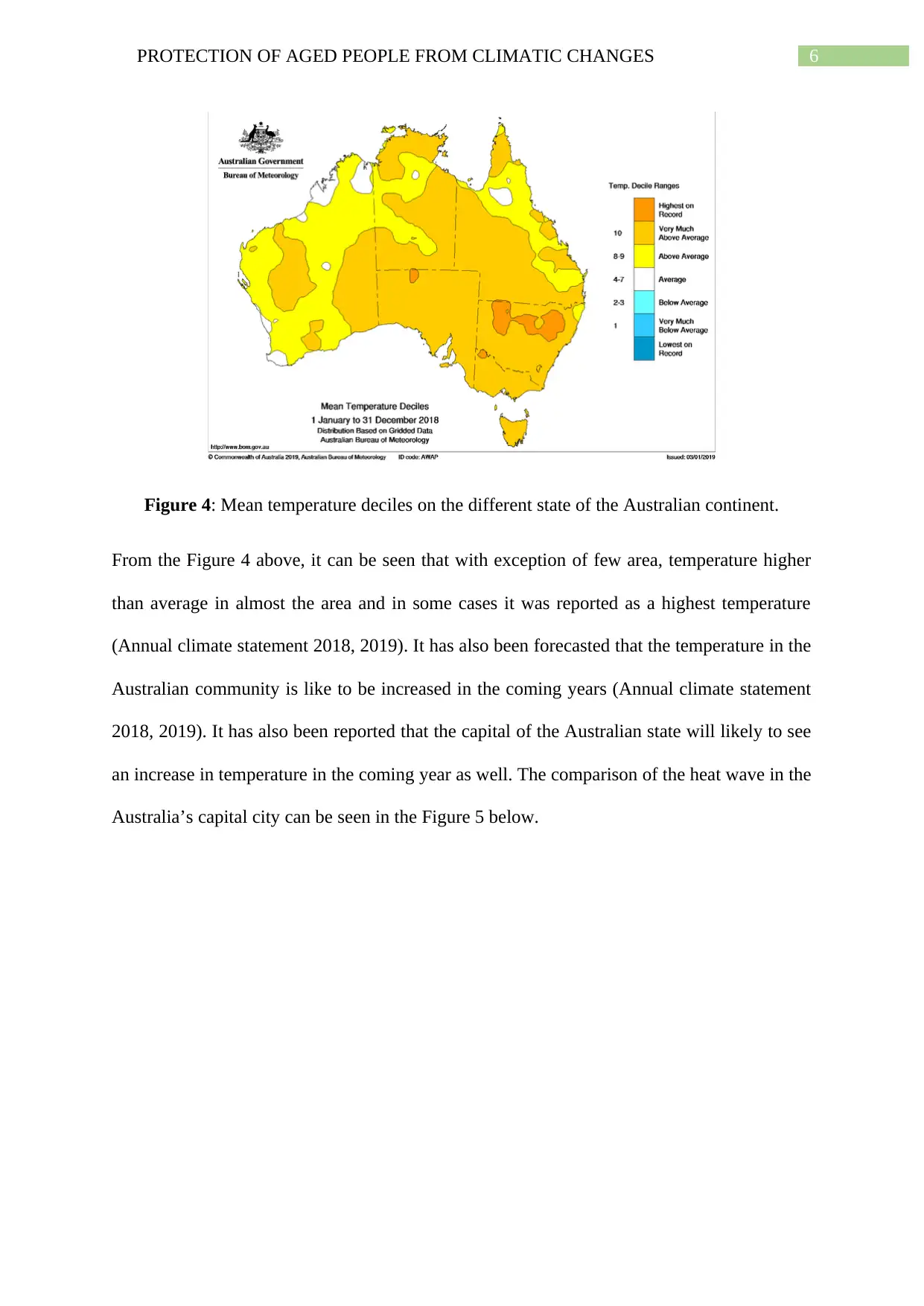
6PROTECTION OF AGED PEOPLE FROM CLIMATIC CHANGES
Figure 4: Mean temperature deciles on the different state of the Australian continent.
From the Figure 4 above, it can be seen that with exception of few area, temperature higher
than average in almost the area and in some cases it was reported as a highest temperature
(Annual climate statement 2018, 2019). It has also been forecasted that the temperature in the
Australian community is like to be increased in the coming years (Annual climate statement
2018, 2019). It has also been reported that the capital of the Australian state will likely to see
an increase in temperature in the coming year as well. The comparison of the heat wave in the
Australia’s capital city can be seen in the Figure 5 below.
Figure 4: Mean temperature deciles on the different state of the Australian continent.
From the Figure 4 above, it can be seen that with exception of few area, temperature higher
than average in almost the area and in some cases it was reported as a highest temperature
(Annual climate statement 2018, 2019). It has also been forecasted that the temperature in the
Australian community is like to be increased in the coming years (Annual climate statement
2018, 2019). It has also been reported that the capital of the Australian state will likely to see
an increase in temperature in the coming year as well. The comparison of the heat wave in the
Australia’s capital city can be seen in the Figure 5 below.
Paraphrase This Document
Need a fresh take? Get an instant paraphrase of this document with our AI Paraphraser
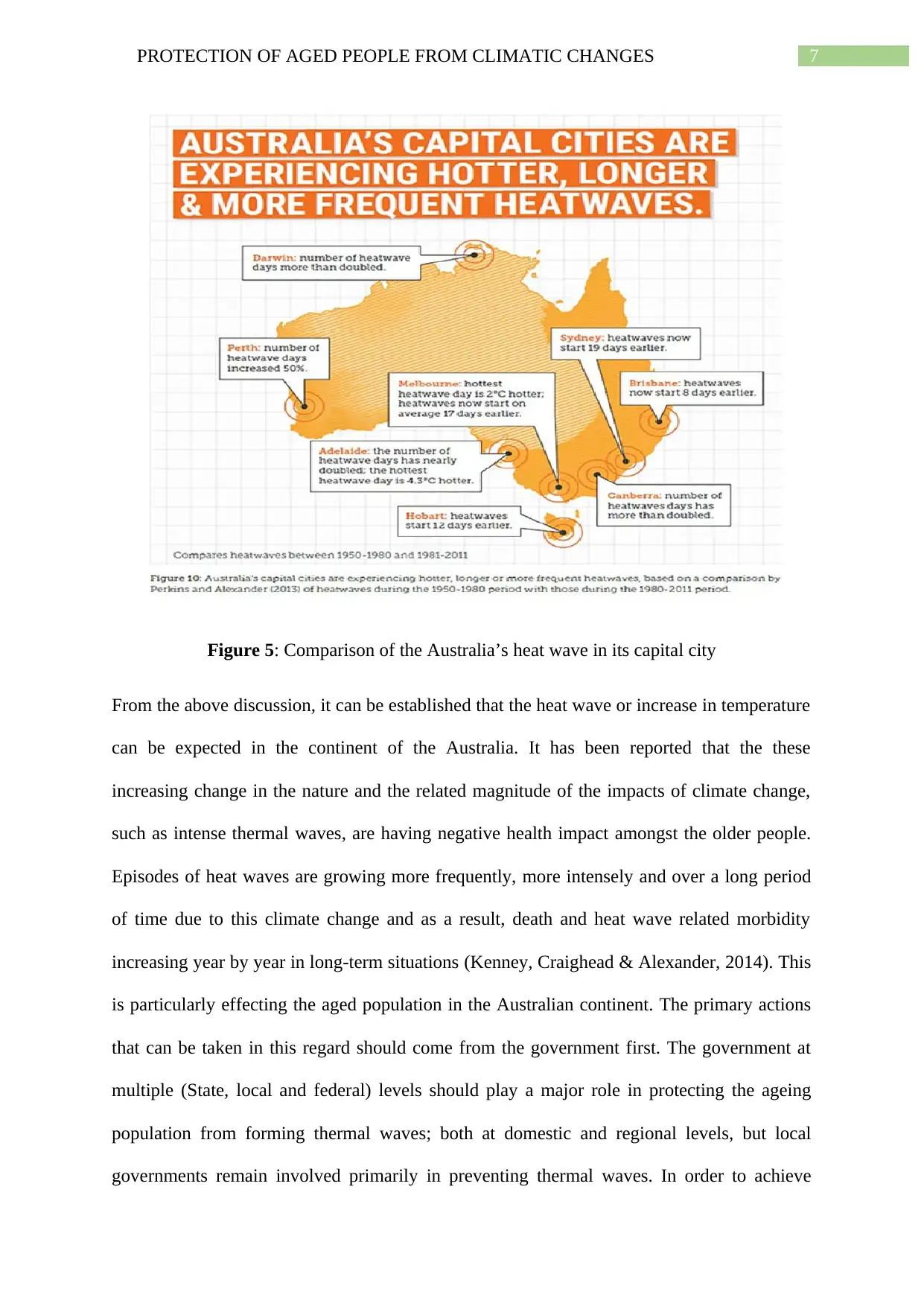
7PROTECTION OF AGED PEOPLE FROM CLIMATIC CHANGES
Figure 5: Comparison of the Australia’s heat wave in its capital city
From the above discussion, it can be established that the heat wave or increase in temperature
can be expected in the continent of the Australia. It has been reported that the these
increasing change in the nature and the related magnitude of the impacts of climate change,
such as intense thermal waves, are having negative health impact amongst the older people.
Episodes of heat waves are growing more frequently, more intensely and over a long period
of time due to this climate change and as a result, death and heat wave related morbidity
increasing year by year in long-term situations (Kenney, Craighead & Alexander, 2014). This
is particularly effecting the aged population in the Australian continent. The primary actions
that can be taken in this regard should come from the government first. The government at
multiple (State, local and federal) levels should play a major role in protecting the ageing
population from forming thermal waves; both at domestic and regional levels, but local
governments remain involved primarily in preventing thermal waves. In order to achieve
Figure 5: Comparison of the Australia’s heat wave in its capital city
From the above discussion, it can be established that the heat wave or increase in temperature
can be expected in the continent of the Australia. It has been reported that the these
increasing change in the nature and the related magnitude of the impacts of climate change,
such as intense thermal waves, are having negative health impact amongst the older people.
Episodes of heat waves are growing more frequently, more intensely and over a long period
of time due to this climate change and as a result, death and heat wave related morbidity
increasing year by year in long-term situations (Kenney, Craighead & Alexander, 2014). This
is particularly effecting the aged population in the Australian continent. The primary actions
that can be taken in this regard should come from the government first. The government at
multiple (State, local and federal) levels should play a major role in protecting the ageing
population from forming thermal waves; both at domestic and regional levels, but local
governments remain involved primarily in preventing thermal waves. In order to achieve
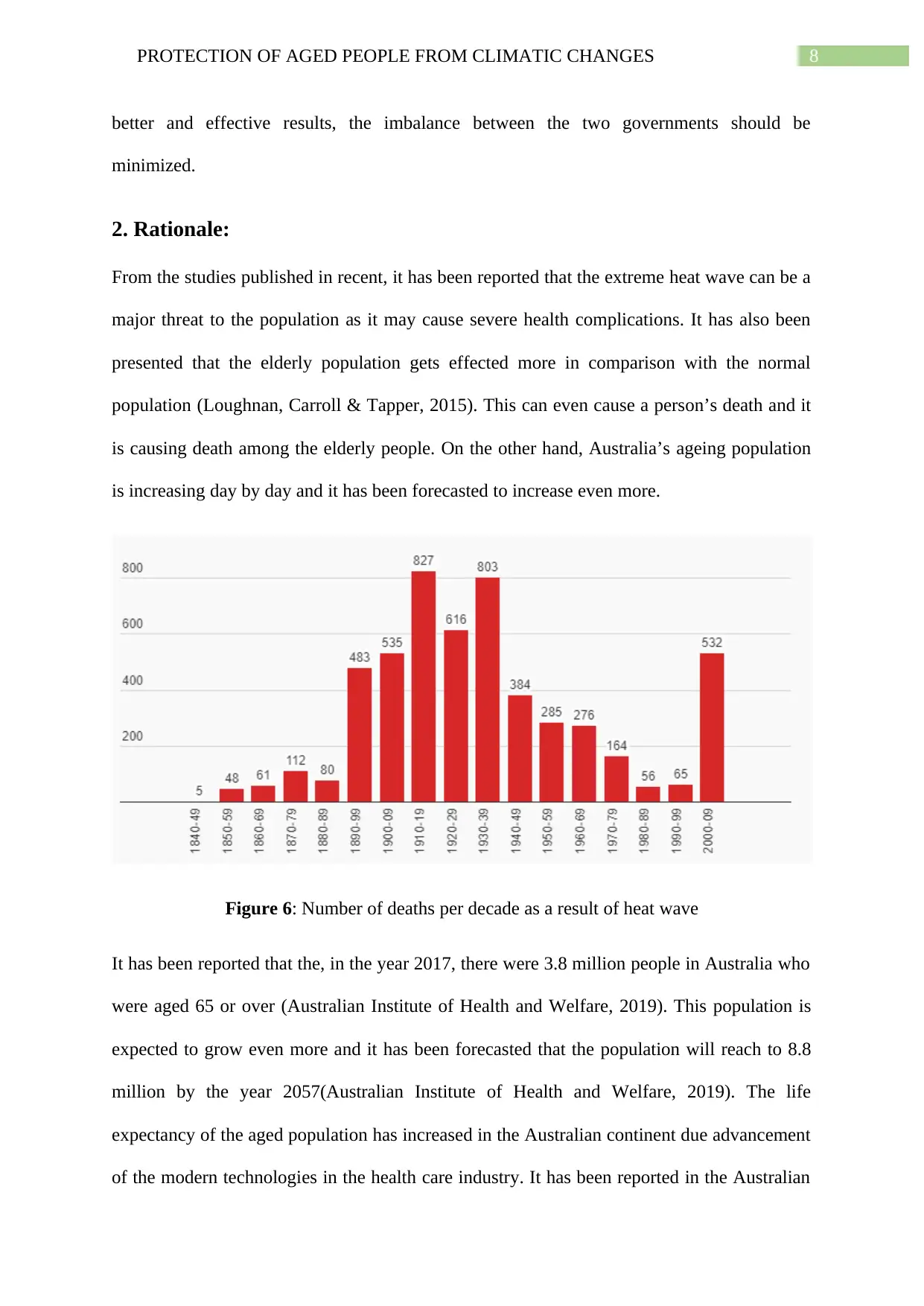
8PROTECTION OF AGED PEOPLE FROM CLIMATIC CHANGES
better and effective results, the imbalance between the two governments should be
minimized.
2. Rationale:
From the studies published in recent, it has been reported that the extreme heat wave can be a
major threat to the population as it may cause severe health complications. It has also been
presented that the elderly population gets effected more in comparison with the normal
population (Loughnan, Carroll & Tapper, 2015). This can even cause a person’s death and it
is causing death among the elderly people. On the other hand, Australia’s ageing population
is increasing day by day and it has been forecasted to increase even more.
Figure 6: Number of deaths per decade as a result of heat wave
It has been reported that the, in the year 2017, there were 3.8 million people in Australia who
were aged 65 or over (Australian Institute of Health and Welfare, 2019). This population is
expected to grow even more and it has been forecasted that the population will reach to 8.8
million by the year 2057(Australian Institute of Health and Welfare, 2019). The life
expectancy of the aged population has increased in the Australian continent due advancement
of the modern technologies in the health care industry. It has been reported in the Australian
better and effective results, the imbalance between the two governments should be
minimized.
2. Rationale:
From the studies published in recent, it has been reported that the extreme heat wave can be a
major threat to the population as it may cause severe health complications. It has also been
presented that the elderly population gets effected more in comparison with the normal
population (Loughnan, Carroll & Tapper, 2015). This can even cause a person’s death and it
is causing death among the elderly people. On the other hand, Australia’s ageing population
is increasing day by day and it has been forecasted to increase even more.
Figure 6: Number of deaths per decade as a result of heat wave
It has been reported that the, in the year 2017, there were 3.8 million people in Australia who
were aged 65 or over (Australian Institute of Health and Welfare, 2019). This population is
expected to grow even more and it has been forecasted that the population will reach to 8.8
million by the year 2057(Australian Institute of Health and Welfare, 2019). The life
expectancy of the aged population has increased in the Australian continent due advancement
of the modern technologies in the health care industry. It has been reported in the Australian
⊘ This is a preview!⊘
Do you want full access?
Subscribe today to unlock all pages.

Trusted by 1+ million students worldwide
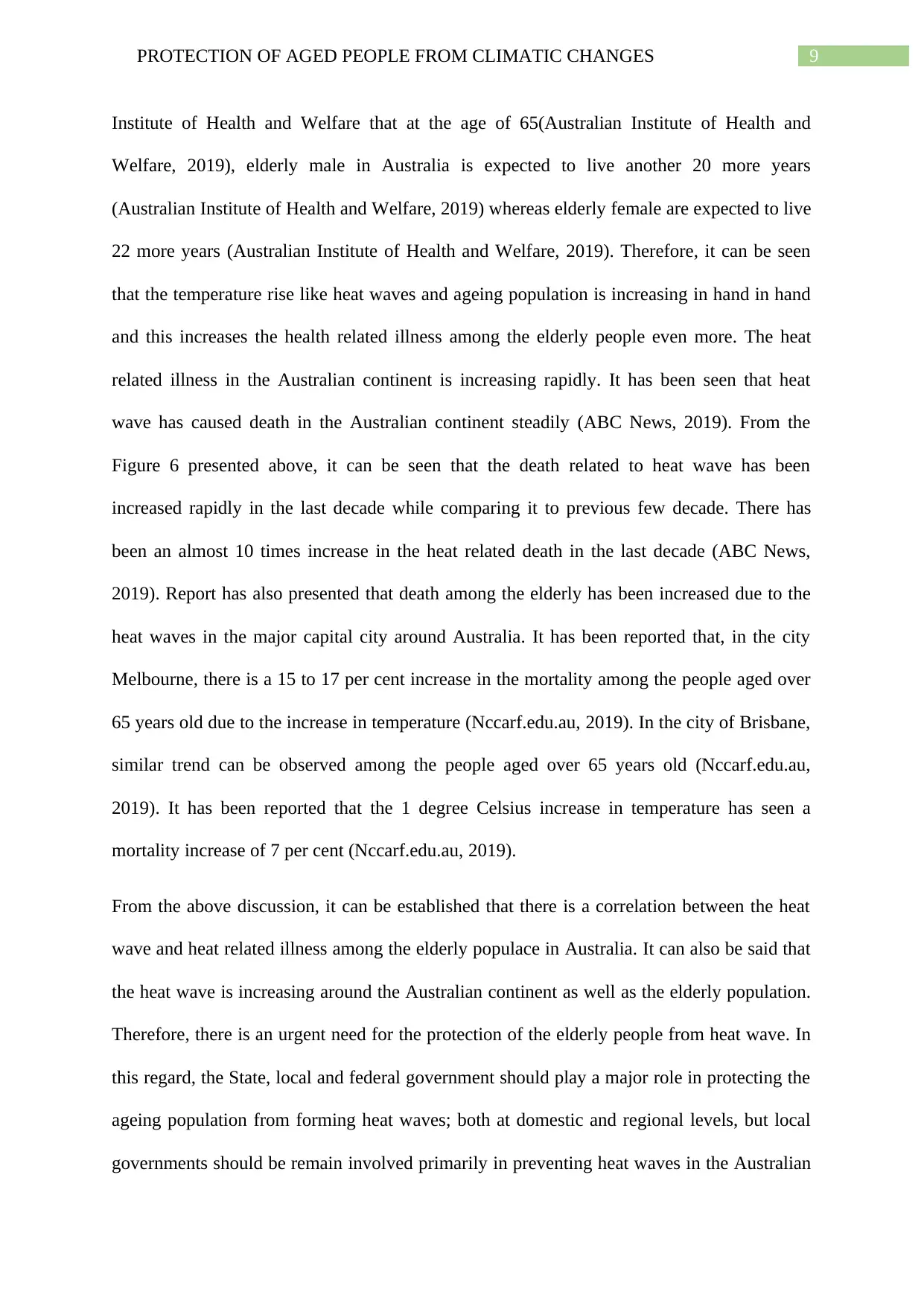
9PROTECTION OF AGED PEOPLE FROM CLIMATIC CHANGES
Institute of Health and Welfare that at the age of 65(Australian Institute of Health and
Welfare, 2019), elderly male in Australia is expected to live another 20 more years
(Australian Institute of Health and Welfare, 2019) whereas elderly female are expected to live
22 more years (Australian Institute of Health and Welfare, 2019). Therefore, it can be seen
that the temperature rise like heat waves and ageing population is increasing in hand in hand
and this increases the health related illness among the elderly people even more. The heat
related illness in the Australian continent is increasing rapidly. It has been seen that heat
wave has caused death in the Australian continent steadily (ABC News, 2019). From the
Figure 6 presented above, it can be seen that the death related to heat wave has been
increased rapidly in the last decade while comparing it to previous few decade. There has
been an almost 10 times increase in the heat related death in the last decade (ABC News,
2019). Report has also presented that death among the elderly has been increased due to the
heat waves in the major capital city around Australia. It has been reported that, in the city
Melbourne, there is a 15 to 17 per cent increase in the mortality among the people aged over
65 years old due to the increase in temperature (Nccarf.edu.au, 2019). In the city of Brisbane,
similar trend can be observed among the people aged over 65 years old (Nccarf.edu.au,
2019). It has been reported that the 1 degree Celsius increase in temperature has seen a
mortality increase of 7 per cent (Nccarf.edu.au, 2019).
From the above discussion, it can be established that there is a correlation between the heat
wave and heat related illness among the elderly populace in Australia. It can also be said that
the heat wave is increasing around the Australian continent as well as the elderly population.
Therefore, there is an urgent need for the protection of the elderly people from heat wave. In
this regard, the State, local and federal government should play a major role in protecting the
ageing population from forming heat waves; both at domestic and regional levels, but local
governments should be remain involved primarily in preventing heat waves in the Australian
Institute of Health and Welfare that at the age of 65(Australian Institute of Health and
Welfare, 2019), elderly male in Australia is expected to live another 20 more years
(Australian Institute of Health and Welfare, 2019) whereas elderly female are expected to live
22 more years (Australian Institute of Health and Welfare, 2019). Therefore, it can be seen
that the temperature rise like heat waves and ageing population is increasing in hand in hand
and this increases the health related illness among the elderly people even more. The heat
related illness in the Australian continent is increasing rapidly. It has been seen that heat
wave has caused death in the Australian continent steadily (ABC News, 2019). From the
Figure 6 presented above, it can be seen that the death related to heat wave has been
increased rapidly in the last decade while comparing it to previous few decade. There has
been an almost 10 times increase in the heat related death in the last decade (ABC News,
2019). Report has also presented that death among the elderly has been increased due to the
heat waves in the major capital city around Australia. It has been reported that, in the city
Melbourne, there is a 15 to 17 per cent increase in the mortality among the people aged over
65 years old due to the increase in temperature (Nccarf.edu.au, 2019). In the city of Brisbane,
similar trend can be observed among the people aged over 65 years old (Nccarf.edu.au,
2019). It has been reported that the 1 degree Celsius increase in temperature has seen a
mortality increase of 7 per cent (Nccarf.edu.au, 2019).
From the above discussion, it can be established that there is a correlation between the heat
wave and heat related illness among the elderly populace in Australia. It can also be said that
the heat wave is increasing around the Australian continent as well as the elderly population.
Therefore, there is an urgent need for the protection of the elderly people from heat wave. In
this regard, the State, local and federal government should play a major role in protecting the
ageing population from forming heat waves; both at domestic and regional levels, but local
governments should be remain involved primarily in preventing heat waves in the Australian
Paraphrase This Document
Need a fresh take? Get an instant paraphrase of this document with our AI Paraphraser
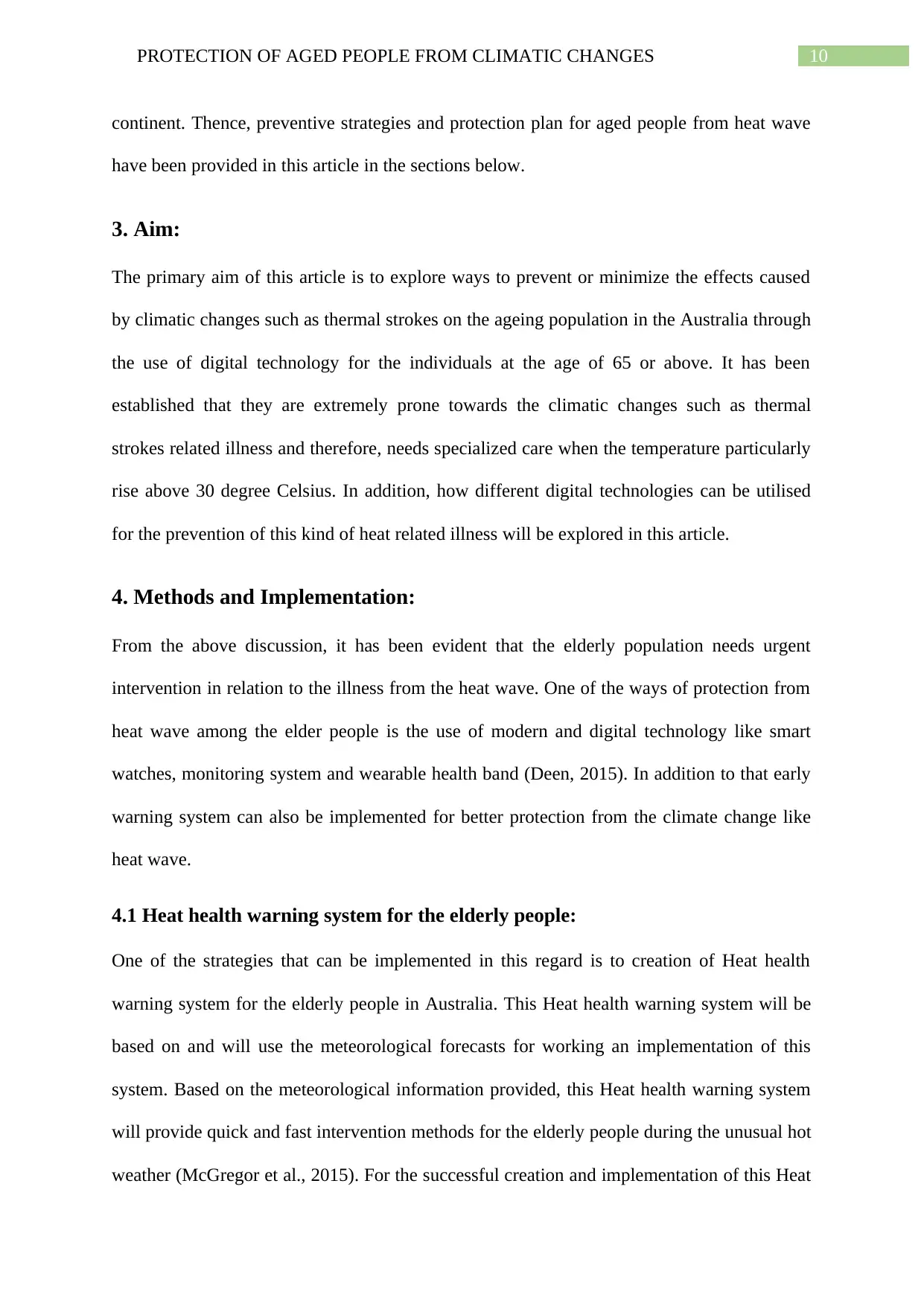
10PROTECTION OF AGED PEOPLE FROM CLIMATIC CHANGES
continent. Thence, preventive strategies and protection plan for aged people from heat wave
have been provided in this article in the sections below.
3. Aim:
The primary aim of this article is to explore ways to prevent or minimize the effects caused
by climatic changes such as thermal strokes on the ageing population in the Australia through
the use of digital technology for the individuals at the age of 65 or above. It has been
established that they are extremely prone towards the climatic changes such as thermal
strokes related illness and therefore, needs specialized care when the temperature particularly
rise above 30 degree Celsius. In addition, how different digital technologies can be utilised
for the prevention of this kind of heat related illness will be explored in this article.
4. Methods and Implementation:
From the above discussion, it has been evident that the elderly population needs urgent
intervention in relation to the illness from the heat wave. One of the ways of protection from
heat wave among the elder people is the use of modern and digital technology like smart
watches, monitoring system and wearable health band (Deen, 2015). In addition to that early
warning system can also be implemented for better protection from the climate change like
heat wave.
4.1 Heat health warning system for the elderly people:
One of the strategies that can be implemented in this regard is to creation of Heat health
warning system for the elderly people in Australia. This Heat health warning system will be
based on and will use the meteorological forecasts for working an implementation of this
system. Based on the meteorological information provided, this Heat health warning system
will provide quick and fast intervention methods for the elderly people during the unusual hot
weather (McGregor et al., 2015). For the successful creation and implementation of this Heat
continent. Thence, preventive strategies and protection plan for aged people from heat wave
have been provided in this article in the sections below.
3. Aim:
The primary aim of this article is to explore ways to prevent or minimize the effects caused
by climatic changes such as thermal strokes on the ageing population in the Australia through
the use of digital technology for the individuals at the age of 65 or above. It has been
established that they are extremely prone towards the climatic changes such as thermal
strokes related illness and therefore, needs specialized care when the temperature particularly
rise above 30 degree Celsius. In addition, how different digital technologies can be utilised
for the prevention of this kind of heat related illness will be explored in this article.
4. Methods and Implementation:
From the above discussion, it has been evident that the elderly population needs urgent
intervention in relation to the illness from the heat wave. One of the ways of protection from
heat wave among the elder people is the use of modern and digital technology like smart
watches, monitoring system and wearable health band (Deen, 2015). In addition to that early
warning system can also be implemented for better protection from the climate change like
heat wave.
4.1 Heat health warning system for the elderly people:
One of the strategies that can be implemented in this regard is to creation of Heat health
warning system for the elderly people in Australia. This Heat health warning system will be
based on and will use the meteorological forecasts for working an implementation of this
system. Based on the meteorological information provided, this Heat health warning system
will provide quick and fast intervention methods for the elderly people during the unusual hot
weather (McGregor et al., 2015). For the successful creation and implementation of this Heat
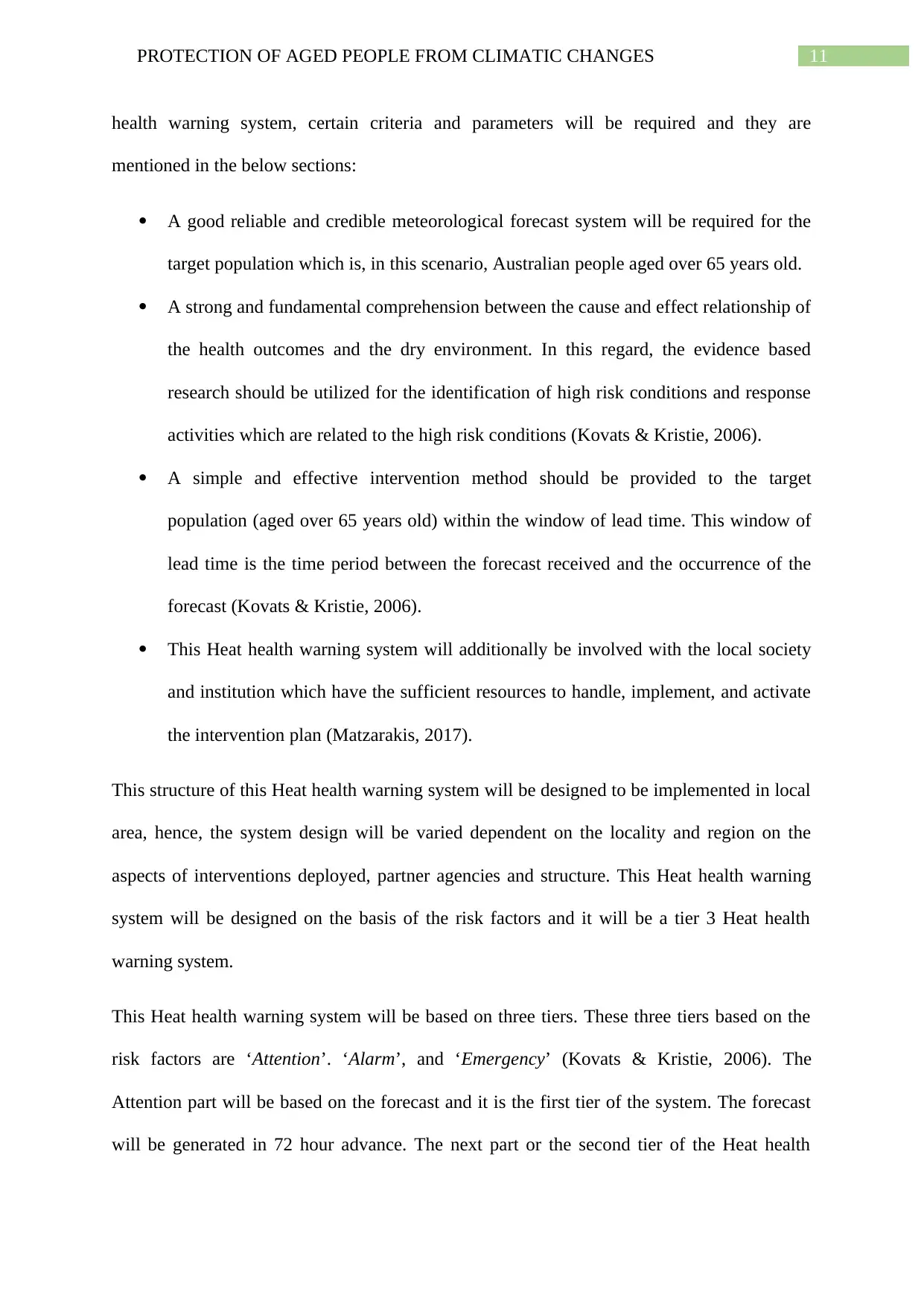
11PROTECTION OF AGED PEOPLE FROM CLIMATIC CHANGES
health warning system, certain criteria and parameters will be required and they are
mentioned in the below sections:
A good reliable and credible meteorological forecast system will be required for the
target population which is, in this scenario, Australian people aged over 65 years old.
A strong and fundamental comprehension between the cause and effect relationship of
the health outcomes and the dry environment. In this regard, the evidence based
research should be utilized for the identification of high risk conditions and response
activities which are related to the high risk conditions (Kovats & Kristie, 2006).
A simple and effective intervention method should be provided to the target
population (aged over 65 years old) within the window of lead time. This window of
lead time is the time period between the forecast received and the occurrence of the
forecast (Kovats & Kristie, 2006).
This Heat health warning system will additionally be involved with the local society
and institution which have the sufficient resources to handle, implement, and activate
the intervention plan (Matzarakis, 2017).
This structure of this Heat health warning system will be designed to be implemented in local
area, hence, the system design will be varied dependent on the locality and region on the
aspects of interventions deployed, partner agencies and structure. This Heat health warning
system will be designed on the basis of the risk factors and it will be a tier 3 Heat health
warning system.
This Heat health warning system will be based on three tiers. These three tiers based on the
risk factors are ‘Attention’. ‘Alarm’, and ‘Emergency’ (Kovats & Kristie, 2006). The
Attention part will be based on the forecast and it is the first tier of the system. The forecast
will be generated in 72 hour advance. The next part or the second tier of the Heat health
health warning system, certain criteria and parameters will be required and they are
mentioned in the below sections:
A good reliable and credible meteorological forecast system will be required for the
target population which is, in this scenario, Australian people aged over 65 years old.
A strong and fundamental comprehension between the cause and effect relationship of
the health outcomes and the dry environment. In this regard, the evidence based
research should be utilized for the identification of high risk conditions and response
activities which are related to the high risk conditions (Kovats & Kristie, 2006).
A simple and effective intervention method should be provided to the target
population (aged over 65 years old) within the window of lead time. This window of
lead time is the time period between the forecast received and the occurrence of the
forecast (Kovats & Kristie, 2006).
This Heat health warning system will additionally be involved with the local society
and institution which have the sufficient resources to handle, implement, and activate
the intervention plan (Matzarakis, 2017).
This structure of this Heat health warning system will be designed to be implemented in local
area, hence, the system design will be varied dependent on the locality and region on the
aspects of interventions deployed, partner agencies and structure. This Heat health warning
system will be designed on the basis of the risk factors and it will be a tier 3 Heat health
warning system.
This Heat health warning system will be based on three tiers. These three tiers based on the
risk factors are ‘Attention’. ‘Alarm’, and ‘Emergency’ (Kovats & Kristie, 2006). The
Attention part will be based on the forecast and it is the first tier of the system. The forecast
will be generated in 72 hour advance. The next part or the second tier of the Heat health
⊘ This is a preview!⊘
Do you want full access?
Subscribe today to unlock all pages.

Trusted by 1+ million students worldwide
1 out of 22
Related Documents
Your All-in-One AI-Powered Toolkit for Academic Success.
+13062052269
info@desklib.com
Available 24*7 on WhatsApp / Email
![[object Object]](/_next/static/media/star-bottom.7253800d.svg)
Unlock your academic potential
Copyright © 2020–2025 A2Z Services. All Rights Reserved. Developed and managed by ZUCOL.



